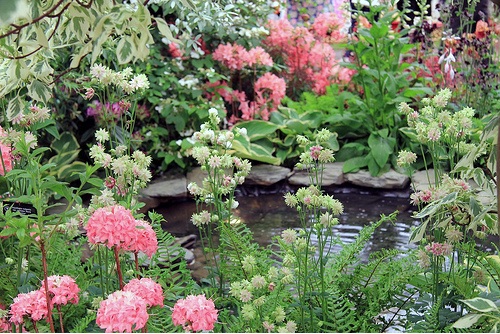<h3><strong>Why start a garden?</strong></h3>
<p>One of the first things most children yearn to do is play in the dirt, and for many of us it’s an obsession we never grow out of. There is something wonderfully therapeutic about a garden. A brief internet search will return multiple studies that prove immersing ourselves in nature can relieve stress, and can actually hasten the healing process in cases of injury or trauma.</p>
<p>Enjoying the outdoors is more popular than ever, and with people spending increased time in their garden offices, summer houses and gazebos, what better way to take a decompression break than to pause and enjoy the serenity of your own garden?</p>
<p style="text-align: center"><img class="aligncenter" alt="flowers" src="http://myblogguest.com/forum/uploads/articles/2013/9/mbg_2.jpg" width="510" height="344" /></p>
<p> Image by Karen Roe</p>
<h3><strong>The Right Size</strong></h3>
<p>The first thing you need to decide is the size. You can settle for something as simple as a window box hanging on the side of your flat, or a sprawling plant-scape that rivals Kew Gardens – it depends purely on how much time and money you want to invest in your pursuits. Start small, but don’t be surprised if the scope of the project grows as you start to see the results of your work.</p>
<h3><strong>The Perfect Spot</strong></h3>
<p>The next step is to select a location – and yes, everyone has a suitable area. Plants can be found in warm, boggy marshes under dense canopy, or growing in arid, wind-swept mountain ranges. Some particularly tenacious weeds even manage to grow through my concrete driveway! So you will find the right spot for your flowerbed.</p>
<p>There are two approaches to selecting an appropriate place. You either decide what plants to grow and then select a spot that&#8217;s right for them, or if you are like most people, you choose the location and grow the things that seem to like it there. But be prepared for a bit of trial and error. A multitude of books and websites can be consulted that will tell you the best environment for each plant, but it has been my experience that sometimes the plant hasn’t read the book, and will thwart your best efforts to encourage its growth.</p>
<p>Don&#8217;t be afraid to move stuff around and see where it thrives best. The three main factors in considering a location are light, drainage, and to some extent luck – although you don&#8217;t need as much luck if you have a greenhouse, because you will easily be able to control all of nature’s variables, including moisture and temperature. This allows you to grow all manner of exotic flora from around the globe.</p>
<h3><strong>Edible Benefits</strong></h3>
<p>While flowers provide us with visual splendour, many people have discovered the joy of vegetable gardening. It saves money, ensures that you know exactly what you are eating, and remember: the scraps (along with fallen leaves and grass cuttings) can even be recycled back into the soil to provide valuable nutrients in the form of compost – allowing you to do your part to help the circle of life and save the planet.</p>
<h3><strong>Visibility</strong></h3>
<p>Lastly, of course, that garden should be visible so pick a spot for maximum visual impact. What’s the current layout of your garden? Do you have a climbing frame or a sandbox for the kids? Perhaps you’ve got some sort of garden building, like a shed, or a summer house. If so, you want to plant your flowers in such a way that they complement the existing layout of your garden and aren’t just tucked away behind your garden shed.</p>
<h3><strong>Taking Time To Enjoy Your Garden</strong></h3>
<p>Although a garden is never <em>finished</em> as such, it is important to take the time to enjoy your progress. As your garden grows you will soon start to appreciate the glory and beauty of nature. All being well, your finished project will be a charming retreat, where you can get lost in the wonder of colour, growth, and the ever-changing splendour of life. In fact you may even lower that blood pressure at the same time.</p>
<p>What plant would you recommend for novice gardeners?</p>
<h5>Featured images:</h5>
<p><span class="license">License: Creative Commons</span></p>
<p><span class="source">image source</span></p>
<p><strong>Stephen R. Drage </strong>is a freelance author, entrepreneur and award-winning public speaker. Stephen grew up in England but now lives in Atlanta, GA. He recommends Dunster House.</p>

Create Your First Garden: A Beginner’s Guide
